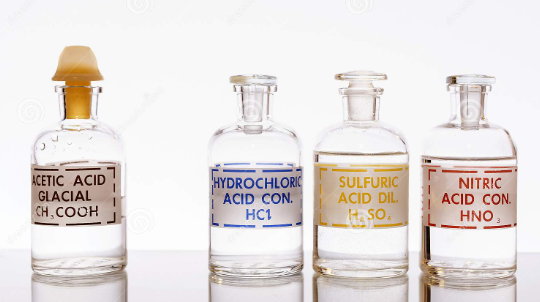Inorganic acid is a compound possessing a non-metallic element or their group and the hydrogen atom. Nitric acid (HNO3), boric acid (H3BO3), hydrochloric acid (HCl), sulphuric acid (H2SO4), phosphoric acid (H3PO4) and carbonic acid (H2CO3) are some examples of inorganic acids. They are relatively soluble in water and are insoluble in organic solvents.
Nitric Acid
Nitric acid, commonly known as the spirit of nitre and aqua fortis, is an example of an inorganic acid having molecular formula (HNO3). Nitric acid is a powerful oxidising agent and can be synthesised by catalytic oxidation of ammonia. It is highly corrosive and can cause intense skin burns.
Nitric acid is a very common reagent used in laboratories. It is used to nitrate oxides, hydroxides, and metals to form nitrate salts. Moreover, it is also used in manufacturing fertilisers and explosives.
Structure of nitric acid
A nitric acid molecule is a neutral molecule composed of one hydrogen atom, one nitrogen atom and three oxygen atoms. One oxygen atom is double bonded to the nitrogen atom, the second oxygen atom is singly bonded to one nitrogen atom and another hydrogen atom, and the third oxygen atom is singly bonded to the nitrogen atom and carries a negative uni charge. The nitrogen atom has a positive uni charge. Therefore, the net charge on nitric acid is zero. The structure of the nitric acid is given below.
Preparation of nitric acid
- Nitric acid can be synthesised by the thermal decomposition of copper(II) nitrate solution, followed by hydrolysis.
2Cu(NO3)2 → 2CuO + 4NO2 + O2
2NO2 + H2O → HNO2 + HNO3
- Nitric acid can also be synthesised by reacting sodium nitrate with sulphuric acid and then distilling at 83 °C.
NaNO3 + H2SO4 → HNO3 + NaHSO4
Physical properties of nitric acid
| Nitric Acid | |
| Common Name | Spirit of nitre and aqua fortis |
| Chemical Formula | HNO3 |
| Structure | |
| Molecular Mass | 63.01 g/mol |
| Melting Point | -42 °C |
| Boiling Point | 83 °C |
| Density | 1.51 g/cm³ |
Boric Acid
Boric acid, typically known as hydrogen borate, orthoboric acid, or boracic acid, is an example of inorganic acid having molecular formula (H3BO3). Boric acid is a mild acid with antifungal, antiviral, and antiseptic effects. It is soluble in water and odourless.
Structure of boric acid
A boric acid molecule is a neutral molecule composed of one boron atom and three hydroxide groups. It possesses trigonal planar geometry with three hydroxide groups attached to the central boron atom. It occupies a net zero charge. The structure of boric acid is given below.
Preparation of boric acid
- Boric acid can be synthesised by reacting borax with any mineral acid like hydrochloric acid.
Na2B4O7.10H2O + 2HCl → 4H3BO3 + 5H2O + 2NaCl
- Boric acid can also be synthesised by hydrolysis of diborane.
B2H6 + H2O → 6H2O → 2B(OH)3 + 6H2
Physical properties of nitric acid
Read know about it Ankha Zone
| Boric Acid | |
| Common Name | Hydrogen borate, orthoboric acid, and boracic acid |
| Chemical Formula | H3BO3 |
| Structure | |
| Molecular Mass | 61.83 g/mol |
| Melting Point | 300 °C |
| Boiling Point | 158 °C |
| Density | 1.435 g/cm³ |
Read also more information legit earth


